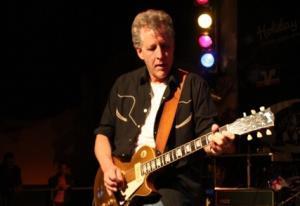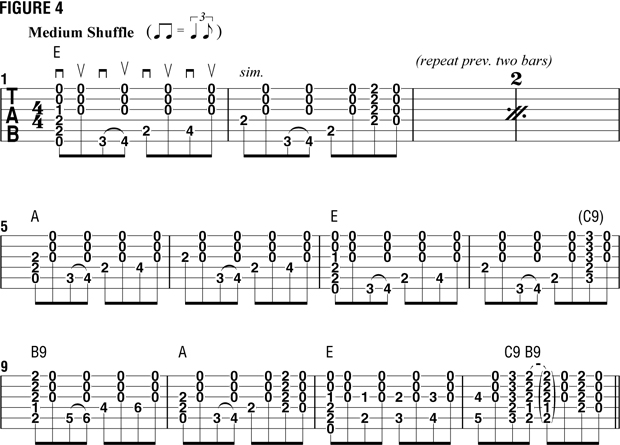Talkin' Blues: All-In-One Shuffle Rhythm

Thirty years ago this November, Stevie Ray Vaughan and Double Trouble laid down the tracks that would become Texas Flood, and among the many jaw-dropping skills Vaughan displayed on his debut album was the massive shuffle groove on “Pride and Joy.” It remains one of the most-requested tunes in the bar-band repertoire but also one of the trickiest to master, so a refresher course in the mechanics of this multilayered rhythm is worthwhile.
The lineage of this groove can be traced to the driving two-handed piano boogie-woogies of the Thirties, adapted by Robert Johnson into the now-ubiquitous guitar boogie shuffle. In the Fifties, artists like Jimmy Reed developed a two-electric-guitar approach, with one playing the boogie bass pattern and the other providing steady piano-style upbeats (check out “Bright Lights, Big City”). On “Pride and Joy,” Vaughan welded these pieces into a single rhythmic wall of sound.

- To build the groove, start with the walking bass line, a series of quarter notes outlining the chord structure (FIGURE 1). Play the open E chord, and then fret the Gs note (fourth fret) with your ring finger. Let the side of the finger touch the fifth string and drape your index finger lightly across the remaining strings, with your fret-hand thumb above the neck. Strum all six strings with a downstroke and adjust the fingering until all strings except the sixth are muted (FIGURE 2). Next, fret the B note (A string, second fret) with your index finger, resting its tip against the sixth string, with the side draped across the upper strings. Strum and adjust until you hear only the B note.
- Fret Cs (A string, fourth fret) with your ring finger, muting in a similar fashion, and fret E on the fourth string with your index finger, muting the sixth string with the side of your thumb and the remaining strings with the tip and side of your index finger. When the muting is accurate around each note, play the pattern slowly in tempo. Don’t pick the notes—strum from the elbow, flat across all six strings. Each note should be sharp and clear with no other pitches sounding around it. Micromanaging the string-muting action with your fretting hand allows maximum freedom for your strumming hand.

Next, add an upstroke across the open top three strings on each upbeat (FIGURE 3). The instant after you strike the strings, mute them by dropping your fretting hand into position for the next bass note. Don’t aim the pick at specific strings—maintain a steady, relaxed strumming motion, hitting all of the strings on each pass while your fretting hand controls the muting. Once the E chord pattern is smooth, apply the same techniques throughout the 12-bar progression (FIGURE 4). On beat two of bars 1–10, hammer-on the fourth-fret bass note on the upbeat while simultaneously strumming the open upper strings with an upstroke. On beat four of bars 2, 4, 10 and 12, barre the chord embellishment with your middle finger.
After you have assembled the parts, play until seamless. About a thousand choruses should do it.
Part 1
Part 2
Part 3
All the latest guitar news, interviews, lessons, reviews, deals and more, direct to your inbox!
